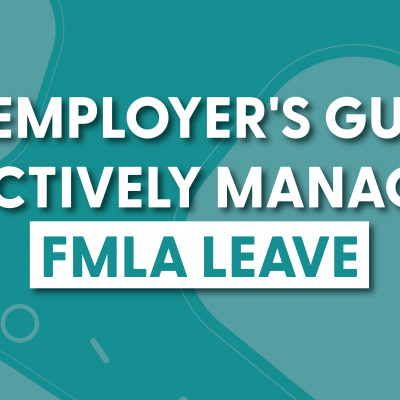You can file this under “O” for “Obvious,” but managing the Family and Medical Leave Act (FMLA) is no walk in the park. The crucial piece of legislation is important for employees seeking to balance work and personal responsibilities, but it can be a complex and challenging process for employers to manage effectively.
Below we’ll delve into the essential steps and strategies that employers must take when dealing with FMLA requests. Moreover, we’ll discuss the importance of open communication, job protection, and health benefits continuation during FMLA leave to maintain a harmonious workplace, as well as tips that help ensure your organization is in compliance with the law.
Enough of the preamble, let’s embark on this journey through the intricacies of FMLA management so you can navigate the terrain successfully.
How to Determine FMLA Eligibility for Employees
When an employee requests a leave of absence, the first step is to ensure that your organization is covered by FMLA. Generally, private-sector employers with 50 or more employees are covered. (Note: If you work for a public agency, including local, state, and federal employers, the FMLA applies to your organization regardless of the number of employees. The same holds true for public school boards and public and private elementary and secondary schools.)
If your organization is covered by FMLA, confirm the employee requesting leave is FMLA eligible by checking they meet the following criteria:
- The employee must have worked for the employer for at least 12 months as of the date FMLA is to start (note: the 12 months do not have to be consecutive)
- The employee must have worked at least 1,250 hours over the 12-month period immediately preceding the leave
- The employee must work at a location where the company employs 50 or more employees within 75 miles.
Employers with remote workforces often struggle with how the “50/75” rule might apply to their population of remote workers, and we offer some perspective on that issue here. It’s also important to note that the employee doesn’t need to mention “FMLA” in order to request leave that is protected by FMLA.
Providing FMLA Notices To Employees
Once the employee’s eligibility status has been determined, HR needs to communicate this determination to the employee. Generally, this should occur within 5 business days of the request for leave. You’ll need to provide written notice of the employee’s rights and responsibilities under the FMLA when you provide the eligibility notice.
You’ll also need to ensure your organization meets general notice requirements under the FMLA, which includes displaying an FMLA poster in plain view for all workers and applicants to see (per the DOL). Covered employers must also provide a general notice containing the same information that is in the poster in its employee handbook (or other written material about leave and benefits), or distribute the general notice to new employees upon hire if no handbook or written leave materials exist.
Requesting Certification for a Leave of Absence
For certain types of FMLA leave, employers are permitted to request certification that supports the employee’s need for leave. When applicable, this documentation can serve as a crucial link between an employee’s request and the legitimacy of their absence, and helps ensure that the FMLA leave is granted for a valid reason.
The employee generally has 15 calendar days to provide the requested documentation, although exceptions may apply. It’s crucial to communicate this requirement clearly to employees and, it can be helpful to follow up to obtain the required certification within the specified timeframe, or understand if an extension of the deadline may be appropriate. By diligently collecting and reviewing certification, employers can ensure that FMLA leave is granted appropriately and in accordance with legal guidelines.
Designating an FMLA Leave
Once an employee has requested FMLA leave and provided the necessary certification or documentation, it’s essential for employers to make a timely determination about whether the leave qualifies under FMLA regulations.
Here’s what’s involved in this designation process:
- Review and Verification: HR or designated personnel should carefully review the documentation provided by the employee. Ensure that the paperwork is sufficient and complete and supports the need for leave for an FMLA-qualifying reason.
- Notification: Unless there are extenuating circumstances, within five business days of receiving the employee’s complete and sufficient certification, employers must notify the employee whether their leave will be designated as FMLA-protected. This notice should clearly state whether the leave qualifies under FMLA, and if so, the notice should include the amount of leave that will count against the employee’s FMLA entitlement, whether the employee is required to use PTO while on FMLA, and whether the employee needs to submit a return-to-work certification to return to work.
- Tracking: Accurate record-keeping is essential during this phase. Maintain a record of the notification sent to the employee, copies of their certification and documentation, and any correspondence related to the leave designation.
- Concurrent Leave: It’s important to coordinate FMLA leave with other forms of paid or unpaid leave an employee may be eligible for, such as state leave law entitlements and company-paid benefits. Properly designating FMLA leave not only informs employees of their rights and responsibilities but also helps employers manage their workforce effectively. It establishes clear boundaries for the leave period, allows for efficient tracking, and ensures compliance with FMLA regulations.
FMLA Leave Tracking and Documentation
Once FMLA leave is designated and an employee begins their approved leave, diligent tracking becomes essential. Maintaining detailed records of FMLA leave helps ensure that your organization complies with legal requirements, including leave duration and FMLA usage. Accurate tracking also allows employers to ensure job protection and benefits continuation for employees on FMLA leave.
While tracking is vital throughout a leave, comprehensive documentation is the backbone of successful FMLA management. Thoroughly record all FMLA-related interactions, decisions, and paperwork, while ensuring that all medical paperwork is kept confidential and in a place that’s separate from the employee’s personnel file. Regardless of whether the leave is approved or denied, documentation can be crucial in case of legal disputes or audits.
Detailed records demonstrate that your organization follows FMLA regulations meticulously, reducing legal risks. It also promotes the consistent application of policies to ensure the fair and equal treatment of all employees.
Proper FMLA tracking and documentation can be a massive headache if you don’t have an effective process in place, but is necessary to help organizations manage their workforce efficiently while complying with FMLA regulations, ensuring a smooth transition for employees returning from leave.
Maintaining Communication Throughout FMLA
Effectively managing FMLA is more than just checking boxes and documenting the heck out of everything. Perhaps the most important thing to remember is that this is a very human event that you’re being asked to manage. Life events your employee population go through that require leave can be some of the most difficult times in their lives, which is why ongoing and open communication with employees on FMLA leave is so important.
Periodic check-ins and updates are not required by FMLA regulations, but they are considered a best practice that demonstrates care for employees while alleviating additional stress during their absence. It’s important to note that these communications should be focused on how the employee is doing and not related to work, or any topic that may cause the employee to feel that they should return sooner than necessary. Staying in touch also allows employers to understand the employee’s progress, expected return date, and any changes in circumstances.
Another overlooked aspect of FMLA management is helping them transition from leave back to work. Return-to-work communication and planning aids in ensuring a smooth transition back to their original (or equivalent) role.
The Importance of Training Managers on FMLA
Managers are great at managing, what they aren’t always so great at is understanding the ins and outs of FMLA. To navigate FMLA effectively, it’s crucial to train managers and equip them with a solid understanding of FMLA regulations and procedures, as well as the know-how required to help identify potential FMLA situations that may require escalation to HR for consideration. This will help ensure that your organization minimizes the risk of legal issues or penalties due to managerial missteps.
Consistency is key, so if managers across your organization are applying FMLA policies non-uniformly you could potentially be in some legal hot water as it pertains to discrimination or other issues. Equipping managers with the knowledge to support employees effectively throughout the FMLA process, however, fosters trust and cooperation, reduces errors and misunderstandings, and helps make for a smooth return-to-work process.
Seek FMLA Legal Advice if Needed
It goes without saying, but if your spidey sense is tingling about any part of your FMLA management process, or if you encounter complex FMLA situations, or just have concerns about FMLA compliance in general, consult with legal counsel or HR professionals with expertise in FMLA regulations.
About Tilt
Tilt is leading the charge in all things leave of absence management through easy-to-use tech and human touch. Since 2017, our proprietary platform and Empathy Warriors have been helping customers make leave not suck by eliminating administrative burdens, keeping companies compliant, and providing a truly positive and supportive leave of absence experience for their people.







